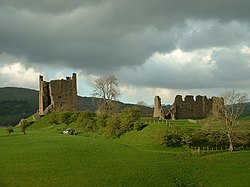Verterae
| Verterae | |
|---|---|
| Brough, Cumbria, England | |

Part of the Roman earthworks, incorporated into a later castle
|
|
| Coordinates | 54°31′34″N 2°19′06″W / 54.52611°N 2.31833°WCoordinates: 54°31′34″N 2°19′06″W / 54.52611°N 2.31833°W |
| Type | Castra |
| Site information | |
| Condition | Earthworks only survive |
| Site history | |
| Built | 1st century AD |
Verterae was a Roman fort in the modern-day village of Brough, Cumbria, England. Occupied between the 1st and 5th centuries AD, is protected a key Roman road in the north of England. In the 11th century, Brough Castle was built on part of the site by the Normans. Archaeologists explored the remains during the 20th century, and it is now protected under UK law.
Verterae was probably built by the Roman governor Gnaeus Julius Agricola between AD 79-80, as part of his campaign to conquer the north of Britain. The name meant "the Forts", and it served as a waypoint on the northern leg of the Roman-era Watling Street, connecting the Roman towns of Luguvalium with Eboracum – the modern-day cities of Carlisle and York – and points further south. One of a sequence of forts that lay every 12 miles (19 km) to 14 miles (23 km) along the route, the site protected the Stainmore Pass that stretched from the River Eden across the Pennines.
The rectangular fort was 3-acre (1.2 ha) in size, constructed on a ridge overlooking the Swindale Beck. The size of the fort is uncertain, due to later work on the site, but it may have been approximately 100 by 110 metres (330 by 360 ft) across east to west, with a ditch up to 15 metres (49 ft) and 6 metres (20 ft) deep in places. A settlement called a vicus and cemetery was constructed on the east side of the fort. The vicus included both stone and wattle-and-daub buildings.
Around the time of the late 4th century and early 5th century, an Auxiliary unit called the Numerus Directorum, around 300-400 strong, were based in the fort.
The site is not far from Maiden Castle. Old gazetters claim this gave the Maiden Way – the old Roman road from nearby Bravoniacum (Kirkby Thore) to Magnae (Carvoran) on Hadrian's Wall – its name.
...
Wikipedia
